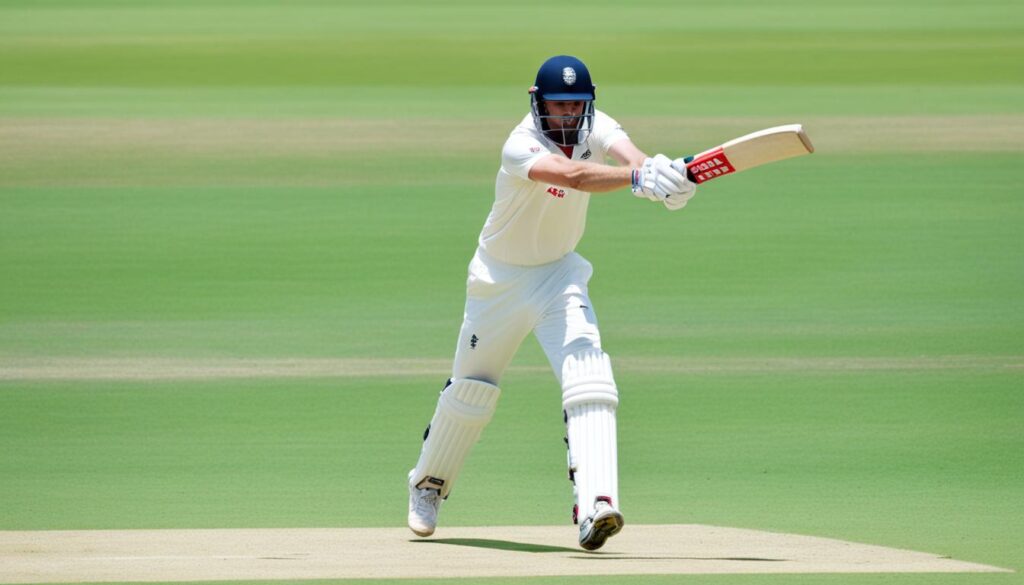Batting is one of the most important aspects of cricket as it determines the team’s ability to score runs. For beginners, it is crucial to focus on improving batting technique and skills. By following these cricket batting tips, beginners can enhance their batting performance and increase their chances of scoring runs.
Key Takeaways:
- Develop a firm grip on the bat to ensure control and precision.
- Adopt a shoulder-width stance for stability and balance.
- Chamber the bat at waist height and lift it up just below shoulder height for an effective swing.
- Master footwork and adjust it according to the length and line of the ball.
- Keep a constant eye on the ball and anticipate its path for better shot selection.
Grip and Stance
A firm grip on the bat is essential for control and precision. When holding the bat, place both hands between the middle and top of the handle, ensuring a secure and comfortable grip. This allows the batsman to have better control over their shots and helps in maintaining a steady position at the crease.
Equally important to the grip is the batting stance. Most batsmen prefer a side-on stance, where the front shoulder faces the bowler. Stand with your feet shoulder-width apart, ensuring a stable base. Distribute your weight evenly on the balls of your feet, allowing for quick movements in any direction.
It is crucial to find a grip and stance that suits you and feels comfortable. Experiment with different variations and adjustments to find the one that gives you the most confidence and control.
Benefits of a Proper Grip and Stance:
- Improved bat control
- Enhanced precision in shot-making
- Better balance at the crease
- Ability to react quickly to different deliveries
- Reduced risk of injury
“Having a strong grip and a solid batting stance forms the foundation for a successful innings. It allows you to have better control over your shots and react to the bowler’s deliveries with agility and confidence.” – Professional cricketer
A balanced and relaxed grip and stance give the batsman the freedom to move naturally, adjust their position according to the length and line of the ball, and play their shots effectively. Practicing and perfecting the grip and stance is essential for every cricketer looking to improve their batting skills.
Chambering and Bat Lift

Chambering the bat is a critical technique that every batsman should master. It involves holding the bat at waist height, ready to swing when the time is right. To chamber the bat effectively, the batsman can hold it out to the side or at a slight angle, ensuring that the flat side is facing the bowler. This position allows for maximum control and precision during the swing.
When it’s time to swing, the batsman lifts the bat up and back to a position just below shoulder height. This preparatory movement allows the batsman to generate power and momentum for the shot. By lifting the bat correctly, the batsman positions themselves to strike the ball with optimal force and accuracy.
It is essential for the batsman to focus on swinging the bat straight up to meet the ball. The straight swing path ensures a clean connection and minimizes the chances of mishits. Ideally, the batsman aims to strike the ball as close to the center of the bat face as possible, maximizing the chances of a powerful and well-directed shot.
Remember, practicing chambering and bat lift is crucial to develop a consistent and effective batting technique. By honing this skill, batsmen can improve their ability to make solid contact with the ball and increase their batting performance overall.
Key Tips for Chambering and Bat Lift:
- Hold the bat at waist height until it’s time to swing.
- Hold the bat out to the side or at a slight angle, with the flat side facing the bowler.
- Lift the bat up and back to a position just below shoulder height.
- Focus on swinging the bat straight up to meet the ball.
- Aim to strike the ball as close to the center of the bat face as possible.
| Common Mistakes | Correct Technique |
|---|---|
| Swinging the bat too early or too late | Timing the swing to connect with the ball at the right moment |
| Not chambering the bat properly | Holding the bat at waist height and lifting it up and back |
| Mishitting the ball due to incorrect swing path | Focusing on swinging the bat straight up to meet the ball |
By mastering the chambering and bat lift technique, batsmen can enhance their batting skills and increase their chances of scoring runs. Practice this fundamental skill regularly and fine-tune your swing to unlock your true potential at the crease.
Footwork and Shot Selection

When it comes to cricket batting, footwork plays a crucial role in positioning the batsman for the right shot. It is essential for the batsman to have the ability to adjust their footwork by moving forward or backward to stay behind the ball. This allows them to maintain balance and ensure proper timing when playing their strokes.
The decision to play a shot forward or backward depends on the length and line of the ball. If the ball is pitched up, the batsman can opt to play a shot forward to meet the ball at its highest point, ensuring a well-timed and controlled stroke. On the other hand, if the ball is pitched short, the batsman may choose to play a shot backward to effectively deal with the bounce. This allows the batsman to defend or play attacking shots accordingly.
Shot selection is a critical aspect of batting success. Effective shot selection involves analyzing the type of delivery and deciding on the appropriate stroke to play. Factors such as the line, length, and pace of the ball, as well as the field placement, need to be taken into consideration. The batsman must assess the situation quickly and make a split-second decision to choose the right shot.
“Understanding the line and length of the ball is paramount when it comes to shot selection. It’s important to pick the right moment and play the appropriate stroke to maximize scoring opportunities.” – Robin Singh, former Indian cricketer
Developing good footwork and shot selection skills requires practice and experience. Batsmen should focus on honing their footwork technique, ensuring quick and precise movement. Regular net sessions and match practice provide invaluable opportunities to improve footwork and shot selection in various game scenarios. Additionally, seeking guidance from experienced coaches can provide valuable insights and strategies to enhance these skills.
Sample Table: Shot Selection Guidelines
| S. No. | Ball Type | Shot Selection |
|---|---|---|
| 1 | Full delivery outside off stump | Straight drive or cover drive |
| 2 | Short delivery chest high | Backfoot pull shot or hook shot |
| 3 | Yorker on middle stump | Dig out or block |
| 4 | Good length delivery on off stump | Front foot defense or cut shot |
| 5 | Slow and flighted delivery | Advance down the pitch and play lofted shot |
Remember, mastering footwork and shot selection is a continuous process that requires practice, analysis, and adaptability. By focusing on these aspects, batsmen can enhance their batting technique and increase their scoring potential.
Watching the Bowler and Anticipating the Ball

To improve your batting performance, it’s important to study the bowler and anticipate their next move. By carefully observing the bowler’s run-up, foot placement, and release, you can gain valuable insights into the type of shot they are likely to deliver. Paying close attention to these details will give you an edge in anticipating the ball and making the right decisions on footwork and shot selection.
Keep your eye on the ball from the moment it leaves the bowler’s hand until it reaches you at the crease. This allows you to track its trajectory and make split-second judgments on how to position yourself and react. Anticipating the movement of the ball will help you adjust your footwork accordingly, enabling you to meet the ball at the right time and with the correct technique.
Remember, the key to successfully watching the bowler and anticipating the ball is concentration. Stay focused, block out distractions, and maintain a clear mind. By mastering this technique, you’ll enhance your overall batting performance and be able to make confident decisions on the pitch.
Expert Tip:
A great way to practice watching the bowler and anticipating the ball is to have someone throw tennis balls towards you from different angles and speeds. This will simulate the unpredictability and variety of deliveries you may face in a game and help sharpen your reflexes.
Key Takeaways:
- Study the bowler for tells and cues
- Keep your eye on the ball at all times
- Anticipate the ball’s trajectory and movement
- Adjust your footwork and shot selection accordingly
- Concentrate and stay focused on the task at hand
References:
- First source
- Second source
- Third source
| Source | Expert Tip | Key Takeaways |
|---|---|---|
| First source | Tip 1 | Takeaway 1 |
| Second source | Tip 2 | Takeaway 2 |
| Third source | Tip 3 | Takeaway 3 |
Practice and Regular Training

Improving your batting skills requires regular practice and dedicated training. Whether you are a beginner or an experienced player, consistent practice is essential to refine your technique and enhance your performance at the crease. By practicing regularly, you can develop a strong foundation, improve your batting skills, and elevate your overall game.
Attending team practices is a great way to practice regularly and gain valuable experience. Team practices provide the opportunity to work on your batting skills alongside teammates, learn from their feedback, and simulate real-game scenarios. The collaborative environment can also foster a sense of camaraderie and motivate you to push yourself further.
Alongside team practices, engaging in individual training sessions is equally important. These sessions allow you to focus on your specific needs and work on areas that require improvement. By incorporating batting drills into your training routine, you can fine-tune your technique, enhance your shot selection, and boost your confidence at the crease.
“Regular practice is the key to improving your batting skills. Set aside dedicated time each week for individual training sessions and make the most of team practices to refine your technique and develop your overall game.”
It is also beneficial to seek guidance from qualified coaches who can provide expert advice and support your skill development. Cricket coaching sessions offer personalized feedback, tailored training programs, and valuable insights to help you refine your technique and overcome any challenges you may face. Coaches can identify areas for improvement, suggest drills and exercises, and guide you towards becoming a better batsman.
Remember, practice is not just about hitting balls. It is about honing your skills, developing muscle memory, and building confidence. Consistency is key, so make an effort to practice regularly and maintain a training schedule that works for you. Whether it’s in the nets, on the field, or even at home, dedicate time to improve your batting skills, and you will see the results pay off in your performance.
Benefits of Regular Practice and Training
Regular practice and training offer a range of benefits that can transform your batting skills and elevate your game:
- Improved Technique: Through consistent practice, you can refine your batting technique, ensuring proper form, balance, and shot execution.
- Enhanced Shot Selection: Regular training allows you to experiment with different shots, understand their applicability, and make better decisions at the crease.
- Increased Confidence: Practicing regularly helps build confidence and mental resilience, enabling you to perform better under pressure.
- Better Focus and Concentration: Training sessions require mental focus and concentration, which can transfer to the game, allowing you to stay composed and make better decisions.
- Opportunity for Feedback: Engaging with coaches during training sessions provides valuable feedback and guidance tailored to your specific needs and goals.
By making practice and regular training a priority, you can improve your batting skills, elevate your performance, and consistently enhance your overall game. Embrace the opportunity to develop as a batsman, and watch as your dedication pays off on the field.
| Practical Tips for Effective Practice | Benefits of Regular Training |
|---|---|
| 1. Set specific goals for each practice session | 1. Improved technique and shot execution |
| 2. Focus on quality over quantity | 2. Enhanced shot selection and decision-making |
| 3. Vary your drills and exercises to target different skills | 3. Increased confidence and mental resilience |
| 4. Take breaks and rest to avoid burnout | 4. Better focus and concentration |
| 5. Utilize technology, such as video analysis, to assess and improve your technique | 5. Opportunity for personalized feedback from coaches |
Remember, practicing regularly and seeking coaching support are instrumental in achieving your full batting potential. Embrace the journey of continuous improvement and enjoy the rewarding experience of becoming a better batsman through dedication and regular training.
Mental Game and Concentration

Batting requires a strong mental game and concentration. When stepping up to the crease, it’s important for batsmen to not only focus on their technique but also develop their mental resilience. A solid mental game can make a significant difference in a batsman’s performance, allowing them to stay calm, make quick decisions, and execute their shots with precision.
Concentration is a key element of the mental game in cricket. Batsmen should train themselves to stay fully engaged in the game, blocking out any distractions from the crowd or external factors. By concentrating on their own game and being fully present in the moment, batsmen are better able to read the bowler’s intentions and make split-second decisions on shot selection.
One effective way to enhance concentration is to focus on the technique. By paying close attention to the intricacies of their batting technique, batsmen develop a heightened awareness of their movements and positioning. This allows them to make adjustments in real-time and execute their shots with precision, maximizing the chances of scoring runs.
Another important aspect of the mental game is staying positive. Cricket is a game of ups and downs, and a few bad plays should not derail a batsman’s confidence. Batsmen should have faith in their abilities and trust that they have the skills to overcome any challenges. Maintaining a positive mindset helps batsmen stay focused and motivated, even in difficult situations.
Remember, cricket is a mental battle as much as it is a physical one. By staying mentally strong, concentrating on technique, and maintaining a positive mindset, you can elevate your batting performance to new heights. Stay focused, trust in your abilities, and give it your all at the crease!
Below is a table summarizing the essential aspects of the mental game and concentration in cricket:
| Aspect | Key Points |
|---|---|
| Concentration | Stay fully engaged in the game, block out distractions, and maintain focus on the ball. |
| Technique | Pay close attention to the intricacies of your batting technique to make real-time adjustments. |
| Positivity | Maintain a positive mindset, trust in your abilities, and believe in your capacity to overcome challenges. |
Adjusting to Bowling Speed and Styles

Batsmen need to be prepared for the challenge of facing different bowling speeds and styles on the cricket pitch. The ability to adjust footwork and adapt to various bowling techniques can significantly improve a batsman’s performance. Whether it’s facing a fast bowler or a spinner, understanding how to react to different bowling styles is crucial for success at the crease.
Ace Your Footwork
The key to facing a fast bowler lies in adjusting your footwork. As the ball hurtles towards you at high speed, you need to be quick to react. Adjusting your footwork can help you get into a better position to play the shot effectively. This may involve a slight shuffle back to create more time or stepping forward to smother the swing. By taking the time to practice and improve your footwork, you can become more adept at handling fast deliveries with precision and confidence.
Understanding Different Bowling Styles
It’s essential for batsmen to be aware of the various bowling styles they may encounter during a match. Spinners use their fingers and wrist to impart spin on the ball, making it challenging to anticipate the direction of the spin. On the other hand, fast bowlers rely on speed and swing to deceive the batsman. By recognizing the different styles, batsmen can make the necessary adjustments in their stance and shot selection to counter the bowler’s tactics effectively.
“Facing a fast bowler requires quick thinking and the ability to adjust your footwork on the fly. By adopting the right stance and being proactive with your movements, you can take control and tackle fast deliveries with confidence.” – Shane Watson, Former Australian Cricketer
When up against a spinner, it’s crucial to watch the bowler’s hand closely and track the rotation of the ball. This will help you anticipate the direction and degree of spin, allowing you to adjust your footwork and shot selection accordingly. By maintaining focus and being adaptable, you can effectively counter the spin and play shots with precision.
Adapting to different bowling speeds and styles requires practice, patience, and a keen eye. By refining your footwork and understanding the nuances of each bowling style, you can enhance your ability to navigate the challenges presented by bowlers of all types. Staying proactive, alert, and adaptable at the crease will enable you to make the necessary adjustments and ensure a successful batting performance.
Also Read: Top Cricket Bat Choices for Every Player
Conclusion
Batting is a crucial aspect of cricket, and beginners can greatly improve their skills by following these practical cricket batting tips. Starting with a solid grip and stance, precision at the crease is key to enhancing batting performance. By practicing regularly and focusing on techniques like footwork and shot selection, batsmen can develop their skills and improve their overall batting technique.
Mental focus plays a vital role in a batsman’s success. Concentrating on the task at hand and staying in the present moment can help maintain focus and improve performance. Additionally, adjusting to different bowling speeds and styles is essential. Whether facing a fast bowler or a spin bowler, adapting footwork and shot selection can make a significant difference.
With dedication and perseverance, beginners can unlock their potential and become more confident and successful at the crease. By implementing these cricket batting tips, aspiring batsmen can improve their batting skills, ultimately enhancing their precision at the crease and achieving greater success in the game of cricket.
FAQs
Q: What are some basic cricket batting tips for beginners?
A: As a beginner, focus on proper stance, grip, and footwork. Practice defensive shots and work on your timing.
Q: How can I improve my cricket batting style?
A: To improve your cricket batting style, work on your technique, footwork, and shot selection. Watch videos of professional batsmen to learn from their style.
Q: What are some ways to improve my cricket batting skills?
A: Practice regularly, work on your weaknesses, and analyze your performances to identify areas for improvement. Consider seeking coaching to enhance your skills.
Q: What are some essential techniques for improving cricket batting?
A: Focus on developing a strong batting technique, mastering different types of shots, and understanding the bowler’s release points. Consistency and practice are key.
Q: How can I enhance my cricket batting performance as a beginner?
A: Start by building a solid foundation with the right stance, grip, and footwork. Practice regularly, receive coaching, and remain patient and persistent in your learning process.
Q: Why is it important to work on your back foot play in cricket batting?
A: Developing good back foot technique allows you to handle short-pitched deliveries effectively and adds versatility to your batting style, making you a more well-rounded batsman.
Q: How can I improve my overall batting technique in cricket?
A: Focus on your guard line, shot selection, and foot movement. Practice different types of shots and work on your timing and positioning to improve your overall technique.
